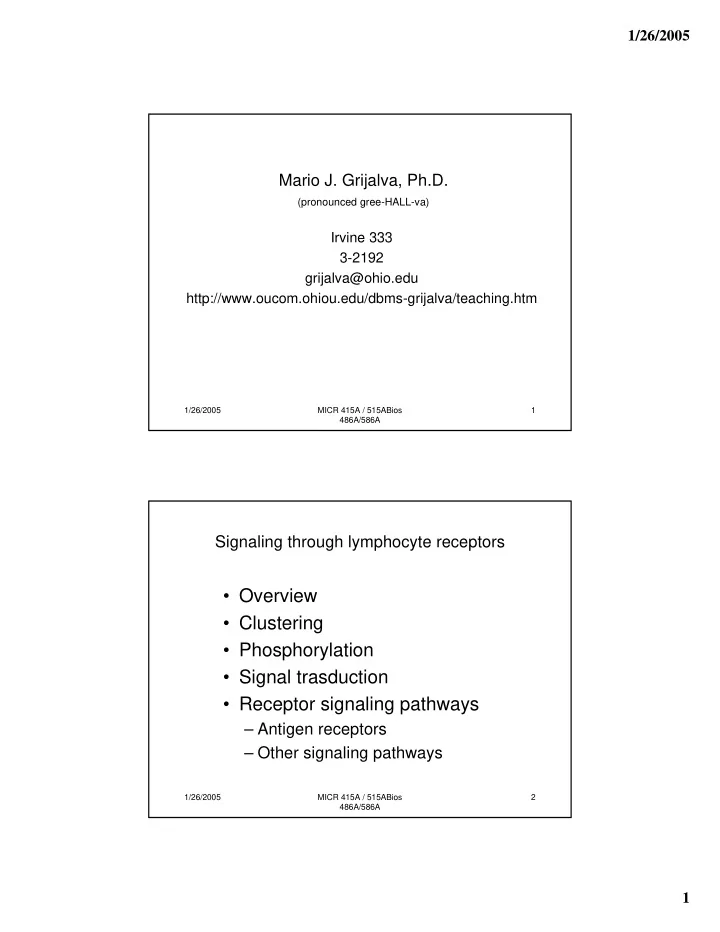

1/26/2005 Mario J. Grijalva, Ph.D. (pronounced gree-HALL-va) Irvine 333 3-2192 grijalva@ohio.edu http://www.oucom.ohiou.edu/dbms-grijalva/teaching.htm 1/26/2005 MICR 415A / 515ABios 1 486A/586A Signaling through lymphocyte receptors • Overview • Clustering • Phosphorylation • Signal trasduction • Receptor signaling pathways – Antigen receptors – Other signaling pathways 1/26/2005 MICR 415A / 515ABios 2 486A/586A 1
1/26/2005 Overview • Cells communicate with their environment through surface receptors • Receptors recognize and bind molecules • Binding creates intracellular signals 1/26/2005 MICR 415A / 515ABios 3 486A/586A “The Cell” How the recognition of an stimuli effects changes on the cell? Signals Response Alter Cell –Cell activation behavior –Cell death –Cell secretion 1/26/2005 MICR 415A / 515ABios 4 486A/586A 2
1/26/2005 Cytotoxic T cell X CTL APC CD8 + virus APC Th 1 Cytokines Cell killing 1/26/2005 MICR 415A / 515ABios 5 486A/586A Signal transduction: “Conversion of signal from one form to another” Extracellular signal “tickles” receptor Th APC CD8 + • Signal activates intracellular biochemical cascades • Activation of transcription factors • Expression (or repression) of genes • Changes on behavior of cell 1/26/2005 MICR 415A / 515ABios 6 486A/586A 3
1/26/2005 Signal Transduction Transmission of a physical signal into a biochemical signal Extracellular receptor binding => activation of gene expression Clustering • Binding to 1 receptor => no signal • Binding to 2 receptors Cross linking => weak signal • Binding many receptors Large cross linking => strong signal 1/26/2005 MICR 415A / 515ABios 7 486A/586A Clustering 1.- Cross-linking of receptors leads to Clustering/aggregation Fig 6.1 1/26/2005 MICR 415A / 515ABios 8 486A/586A 4
1/26/2005 Why clustering? • Receptors complexes have extracellular and intracellular components • Clustering brings together the intracellular components of the receptor complex • The physical proximity of the intracellular components triggers the initiation of the signaling cascade 1/26/2005 MICR 415A / 515ABios 9 486A/586A - Clustering leads to intracellular signaling - Phosphorylation of Proteins Receptor associated tyrosine kinases - Transphosphorylation 1/26/2005 MICR 415A / 515ABios 10 486A/586A 5
1/26/2005 1/26/2005 MICR 415A / 515ABios 11 486A/586A 1/26/2005 MICR 415A / 515ABios 12 486A/586A 6
1/26/2005 Phosphorylation by protein kinases • Protein kinases Phosphorylate proteins – Rapid – No new synthesis of proteins – Reversible by phosphatases • Enzyme Phosphorylated = Active • Enzyme de-phosphorylated = Inactive – Phosphorylation creates new binding sites for other proteins • Phosphorylation creates SH2 & SH3 binding domains • Inmobilize cytosolic proteins that are only active if bound to membrane • Increase the local concentration of proteins – amplification of the signal • Only tyrosine, serine , threonine and histidine residues can be phosphorylated 1/26/2005 MICR 415A / 515ABios 13 486A/586A Adaptor molecules • Phosphorylation creates binding sites for other molecules. 1/26/2005 MICR 415A / 515ABios 14 486A/586A 7
1/26/2005 Adaptor molecules = bridges Phosphorylation creates a SH2 binding domain – Adaptor molecules containing an SH2 domain – These molecules also have SH3 domains – Downstream proteins bind to the SH3 domain and get activated 1/26/2005 MICR 415A / 515ABios 15 486A/586A Phospholipase C - γ (PLC- γ ) • Contains 2 SH2 domains • PLC- γ binds to the adaptor molecule bound to the receptor complex • Phosphorylation of (PLC- γ ) activates the enzyme • Activated PLC- γ propagates and amplifies the signal 1/26/2005 MICR 415A / 515ABios 16 486A/586A 8
1/26/2005 Membrane phospholipid Catabolism Intracellular signaling molecules carry the signal onward and amplify it . Figure 6.4 Phospholipase C - γ (PLC- γ ) PLC- γ PIP 2 DAG +IP 3 IP 3 opens Ca 2+ channels that allow entry from ER. •Phosphatidylinositol-bisphosphate (PIP 2 ) Ca 2+ activates calmodulin •diacylglycerol (DAG) •Inositol triphosphate (IP 3 ) 1/26/2005 MICR 415A / 515ABios DAG activates PKC 17 486A/586A G-Protein activation • GEFs also bind to adaptor molecules • GEFs activate G-Proteins • G proteins activate the MAP Kinase cascade => activation of transcription factors 1/26/2005 MICR 415A / 515ABios 18 486A/586A 9
1/26/2005 1/26/2005 MICR 415A / 515ABios 19 486A/586A Signaling… Protein tyrosine kinases Activation of GTP-binding Membrane phospholipid proteins Catabolism (PLC) MAP & Jun Kinases Ca ++ ; Protein kinase C Activation of Transcription Factors Regulatory sequences Expression of proteins (cytokines, receptors, etc) 1/26/2005 MICR 415A / 515ABios 20 486A/586A 10
1/26/2005 Receptor complex structure – Ag receptors are associated with invariant accessory proteins – Variable chains provide specificity (short cytoplasmic tail) – Invariant accessory proteins participate in 1. Transport of receptor to the membrane 2. Signaling (long cytoplasmic tail) – ITAMS = immunoreceptor tyrosine-based activation motifs 1. Composed of 2 tyrosine residues Immunoreceptor tyrosine-beased activation motifs (ITAMS) 1/26/2005 MICR 415A / 515ABios 21 486A/586A Receptor structure Immunoreceptor tyrosine-beased activation motifs (ITAMS) Figs. 6.7; 6.8 1/26/2005 MICR 415A / 515ABios 22 486A/586A 11
1/26/2005 First steps • Clustering brings together ITAMS • In B-cells ITAMS are phosphorylated by Src family kinases (Blk, Fyn, Lyn) • In T cells Lck, associated with CD4 & CD8 co-receptor molecules also phosphorylates ITAMS 1/26/2005 MICR 415A / 515ABios 23 486A/586A 1/26/2005 MICR 415A / 515ABios 24 Signaling: Protein phosphorylation initiates signaling cascade 486A/586A 12
1/26/2005 1/26/2005 MICR 415A / 515ABios 25 486A/586A 1/26/2005 MICR 415A / 515ABios 26 486A/586A 13
1/26/2005 Other signaling pathways • Cytokines • Toll Like Receptors • Fas-Fas ligand • Apaf1 activation 1/26/2005 MICR 415A / 515ABios 27 486A/586A Cytokine signaling 1/26/2005 MICR 415A / 515ABios 28 486A/586A 14
1/26/2005 1/26/2005 MICR 415A / 515ABios 29 486A/586A Fas - Fas ligand 1/26/2005 MICR 415A / 515ABios 30 486A/586A 15
1/26/2005 Cytocrome C leakage 1/26/2005 MICR 415A / 515ABios 31 486A/586A 1/26/2005 MICR 415A / 515ABios 32 486A/586A 16
1/26/2005 Lecture slides index: http://www.oucom.ohiou.edu/dbms- grijalva/Teaching/ 1/26/2005 MICR 415A / 515ABios 33 486A/586A 17
Recommend
More recommend